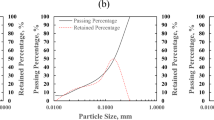Abstract
A previous study showed that clay can be replaced in part by sewage sludge ash (SSA) in tile manufacturing, but the strength of the resulting SSA/clay tiles was inadequate. To extend the resourceful reuse of sewage sludge and improve the properties of SSA/clay tiles, micro carbon powder (MCP) was incorporated as an additive in SSA/clay tiles in this study. Beginning with pure clay, 30 % of the clay was replaced by SSA and sintered at 1100 °C. Next, the effects of four different fractions of MCP (0, 1, 2, and 3 %) on the properties of the SSA/clay tile specimens were studied. The experimental results indicate that the addition of MCP improved the densification of SSA/clay tiles and that 2 % MCP is the optimal additive concentration. When more than 2 % MCP was added, bubbles formed inside the tile body. These bubbles damaged the interior structure of the tiles, weakening them.








Similar content being viewed by others
References
Chen L, Lin DF (2009) Stabilization treatment of soft subgrade soil by sewage sludge ash and cement. J Hazard Mater 162(1):321–327
Chiang KY, Chou PH, Hua CR, Chien KL, Cheeseman C (2009) Lightweight bricks manufactured from water treatment sludge and rice husks. J Hazard Mater 171(1–3):76–82
Donatello S, Cheeseman CR (2013) Recycling and recovery routes for incinerated sewage sludge ash (ISSA): a review. Waste Manag 33(11):2328–2340
Eliche-Quesada D, Martínez-García C, Martínez-Cartas ML, Cotes-Palomino MT, Pérez-Villarejo L, Cruz-Pérez N, Corpas-Iglesias FA (2011) The use of different forms of waste in the manufacture of ceramic bricks. Appl Clay Sci 52(3):270–276
Kayaci B, Kara A, Kayaci K, Samet Küçüker A (2010) Re-use of mud from process waste water purification plant in ceramic tile production. Ind Ceram 30(3):195–207
Konin A (2011) Use of plastic wastes as a binding material in the manufacture of tiles: case of wastes with a basis of polypropylene. Mater Struct 44(8):1381–1387
Lin DF, Luo HL, Zhang SW (2007) Effects of nano-SiO2 on tiles manufactured by clay and incinerated sewage sludge. J Mater Civ Eng ASCE 19(10):801–808
Lin DF, Chang WC, Yuan C, Luo HL (2008) Production and characterization of glazed tiles containing incinerated sewage sludge. Waste Manag 28(3):502–508
Lin KL, Chiang KY, Lin DF (2006) Effect of heating temperature on the sintering characteristics of sewage sludge ash. J Hazard Mater 128(2–3):175–181
Lin KL, Luo HL (2009) Evaluation of sintering characteristics of pavement tiles incorporating waste catalyst. Int J Pavement Res Technol 2(2):68–74
Luo HL, Lin DF, Zhuang ML (2007) Study of the properties of clay and potter’s clay tiles with nano-SiO2 additive. In: Proceedings of the 3rd Chinese environmental forum, Kaohsiung City, Taiwan, p 51
Merino I, Arévalo LF, Romero F (2007) Preparation and characterization of ceramic products by thermal treatment of sewage sludge ashes mixed with different additives. Waste Manag 27:1829–1844
Seynou M, Millogo Y, Ouedraogo R (2013) White paste for stoneware tiles for pavement using raw clay material from Burkina Faso. Mater Struct 46(5):755–763
Sun KD (2001) Reuse of water treatment plant sludge and dam sediment in brick and pavement brick-making. Master Thesis, Institute of Environmental Engineering, National Chiao Tung University, Taiwan
Vidal J, Miguel M (2010) The use of residues in the manufacture of ceramic tile bodies. Interceram 59(2):115–118
Wang DQ, She JY, Yang L (2007) Properties of low melting P2O5–ZnO–MgO–Na2O glasses. Glass Enamel 35(1):36–39
Xu GR, Zou JL, Li GB (2008) Effect of sintering temperature on the characteristics of sludge ceramsite. J Hazard Mater 150(2):394–400
Zhu HG, Deng CJ, Bai C, Luo XY (2008) Synthesis of tiny pore and high density Al2O3–SiC brick. J Wuhan Univ Sci Technol 31(3):263–267
Author information
Authors and Affiliations
Corresponding author
Rights and permissions
About this article
Cite this article
Lin, DF., Luo, HL., Cheng, JF. et al. Strengthening tiles manufactured with sewage sludge ash replacement by adding micro carbon powder. Mater Struct 49, 3559–3567 (2016). https://doi.org/10.1617/s11527-015-0739-7
Received:
Accepted:
Published:
Issue Date:
DOI: https://doi.org/10.1617/s11527-015-0739-7




